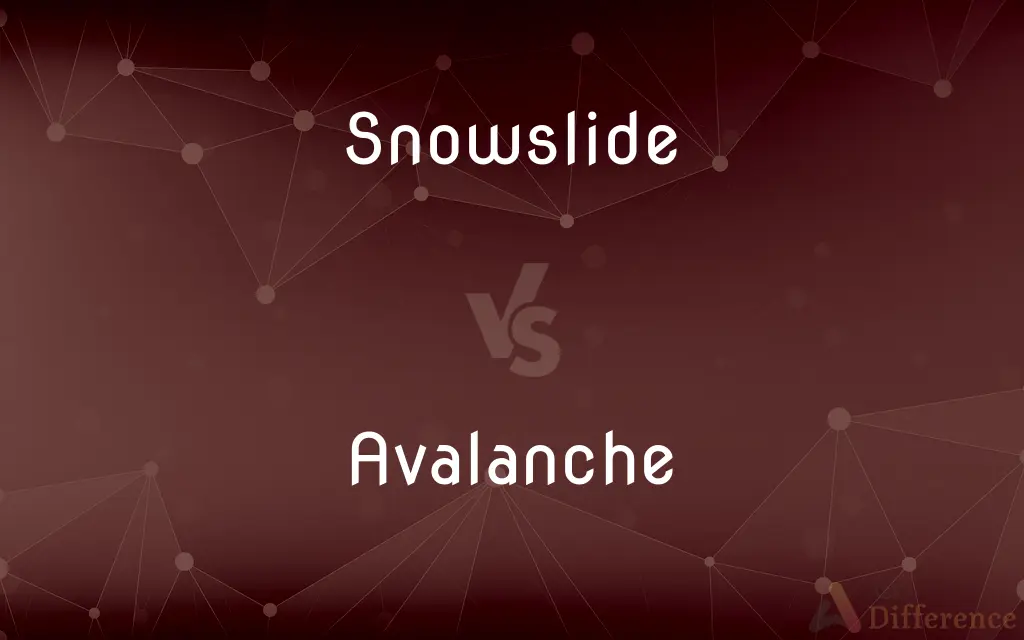Snowslide vs. Avalanche — What's the Difference?
By Urooj Arif & Maham Liaqat — Updated on March 21, 2024
A snowslide is a specific type of avalanche involving the rapid downhill flow of snow, while an avalanche encompasses any rapid flow of snow, ice, or debris down a slope.

Difference Between Snowslide and Avalanche
Table of Contents
ADVERTISEMENT
Key Differences
A snowslide specifically refers to the movement of snow as it slides down a mountain or hill, indicating a more focused phenomenon within the broader category of avalanches. On the other hand, an avalanche can include not only snow but also ice, rock, and other debris that may be swept along as the snow moves downhill, highlighting its potential for greater destruction.
Snowslides occur when the stability of a snowpack is compromised, often due to a combination of factors such as snow layering, temperature changes, and additional weight. Avalanches, while also triggered by similar factors, can be more complex due to the involvement of various materials besides snow, which can alter their behavior and impact.
The term "snowslide" implies a process that is exclusively snow-based, potentially viewed as less severe compared to avalanches that carry additional materials. Avalanches, given their broader definition, are generally considered more dangerous and unpredictable, especially when they involve mixed materials that increase their mass and momentum.
Both snowslides and avalanches pose significant risks to mountainous areas, threatening both human life and infrastructure. However, the risk assessment and management strategies might differ, as avalanches require consideration of a wider range of potential triggers and materials involved.
In terms of mitigation and response, areas prone to snowslides may focus on snowpack management and monitoring temperature fluctuations closely. In contrast, avalanche-prone areas might employ more varied techniques, including the use of barriers and deflection structures to manage not only snow but also ice and debris flow.
ADVERTISEMENT
Comparison Chart
Definition
Rapid movement of snow down a slope
Rapid flow of snow, ice, or debris down a slope
Composition
Exclusively snow
Snow, ice, rock, and other debris
Trigger Factors
Snow layering, temperature, weight
Similar to snowslides, plus additional factors for mixed materials
Severity
Often viewed as less severe
Generally considered more dangerous
Mitigation Techniques
Snowpack management, monitoring temperature
Varied techniques, including barriers and deflection structures
Compare with Definitions
Snowslide
A rapid downhill movement of snow.
The snowslide covered the hiking trail in minutes.
Avalanche
Triggered by various factors.
The avalanche was likely triggered by a combination of snowpack conditions and a small earthquake.
Snowslide
Exclusively involves snow.
The area is prone to snowslides during the spring thaw.
Avalanche
A rapid flow of snow and possibly other materials down a slope.
The avalanche destroyed several homes in its path.
Snowslide
Triggered by instability in the snowpack.
A heavy snowfall triggered a dangerous snowslide.
Avalanche
Can include snow, ice, and debris.
The avalanche was compounded by rocks and ice, increasing its destructiveness.
Snowslide
Requires careful monitoring of conditions.
Rangers monitor the mountain for signs of potential snowslides.
Avalanche
Poses a significant risk to life and property.
Avalanches pose a yearly risk to mountain communities.
Snowslide
A type of avalanche.
Snowslides are among the most common types of avalanches in this region.
Avalanche
Requires comprehensive mitigation strategies.
The government has implemented avalanche barriers to protect the village.
Snowslide
An avalanche of snow.
Avalanche
An avalanche (also called a snowslide) is a rapid flow of snow down a slope, such as a hill or mountain.Avalanches can be set off spontaneously, by such factors as increased precipitation or snowpack weakening, or by external means such as humans, animals, and earthquakes. Primarily composed of flowing snow and air, large avalanches have the capability to capture and move ice, rocks, and trees.
Snowslide
An avalanche of snow
Avalanche
A fall or slide of a large mass of material, especially of snow, down a mountainside.
Avalanche
A massive or overwhelming amount; a flood
Received an avalanche of mail.
Avalanche
To fall or slide in a massive or overwhelming amount.
Avalanche
To overwhelm; inundate.
Avalanche
A large mass or body of snow and ice sliding swiftly down a mountain side, or falling down a precipice.
Avalanche
A fall of earth, rocks, etc., similar to that of an avalanche of snow or ice.
Avalanche
(by extension) A sudden, great, or irresistible descent or influx; anything like an avalanche in suddenness and overwhelming quantity.
Avalanche
(intransitive) To descend like an avalanche.
Avalanche
(transitive) To come down upon; to overwhelm.
The shelf broke and the boxes avalanched the workers.
Avalanche
(transitive) To propel downward like an avalanche.
Avalanche
A large mass or body of snow and ice sliding swiftly down a mountain side, or falling down a precipice.
Avalanche
A fall of earth, rocks, etc., similar to that of an avalanche of snow or ice.
Avalanche
A sudden, great, or irresistible descent or influx of anything.
Avalanche
A slide of large masses of snow and ice and mud down a mountain
Avalanche
A sudden appearance of an overwhelming number of things;
The program brought an avalanche of mail
Avalanche
Of snow masses in the mountains
Common Curiosities
Why are avalanches more dangerous than snowslides?
Avalanches can carry more mass and momentum due to the inclusion of ice, rock, and debris, increasing their destructive potential.
Are all snowslides considered avalanches?
Yes, snowslides are a specific type of avalanche focused solely on the movement of snow.
What factors can trigger a snowslide?
Factors include snow layering, temperature changes, and additional weight on the snowpack.
What is a snowslide?
A snowslide is the rapid downhill movement of snow, typically triggered by instability in the snowpack.
Can human activities trigger snowslides and avalanches?
Yes, activities like skiing, snowboarding, and construction can destabilize the snowpack and trigger these events.
How does an avalanche differ from a snowslide?
An avalanche includes not only snow but also ice, rock, and debris, making it broader and potentially more dangerous than a snowslide.
What is the main focus of snowslide mitigation techniques?
Snowslide mitigation focuses on managing the snowpack and closely monitoring temperature fluctuations.
Is it possible to predict snowslides and avalanches?
While prediction is challenging, monitoring environmental conditions can help assess risks.
Are there warning signs before a snowslide or avalanche occurs?
Yes, there can be warning signs, such as cracking sounds, snowpack movement, or visible snowpack layering.
Do snowslides occur in all snowy regions?
No, they are more likely in mountainous areas with certain snowpack conditions.
Can the time of year affect the likelihood of a snowslide or avalanche?
Yes, changes in weather and temperature, especially during spring, can increase the likelihood.
How do avalanche mitigation techniques differ?
They include a broader range of strategies, such as the use of barriers and deflection structures, to manage not only snow but also other materials.
How can individuals protect themselves in avalanche-prone areas?
By avoiding risky areas, carrying avalanche safety equipment, and staying informed about current conditions.
How do communities prepare for avalanches?
Communities prepare by implementing structural defenses, evacuation plans, and public education programs.
What is the impact of climate change on snowslides and avalanches?
Climate change can alter snowpack stability and weather patterns, potentially affecting the frequency and severity of these events.
Share Your Discovery

Previous Comparison
Lower vs. Below
Next Comparison
Impulse vs. PulseAuthor Spotlight
Written by
Urooj ArifUrooj is a skilled content writer at Ask Difference, known for her exceptional ability to simplify complex topics into engaging and informative content. With a passion for research and a flair for clear, concise writing, she consistently delivers articles that resonate with our diverse audience.
Co-written by
Maham Liaqat















































